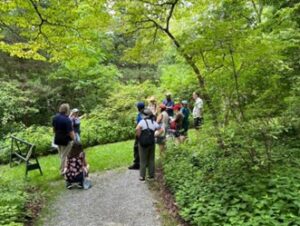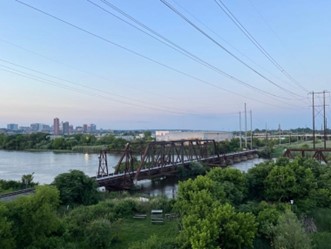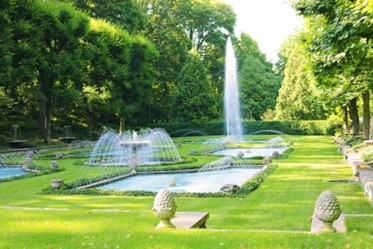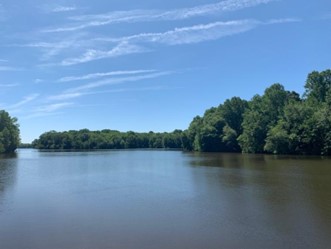The reflection that follows is an assembly of voices representing members of the planning committee, panel moderators, field trip organizers, and more who contributed to the “Watersheds” Symposium that took place from June 24-26 at the University of Delaware. Feel free to read sequentially or to wade around at random! Our thanks to the attendees, sponsors, and staff whose sundry contributions made the symposium run smoothly—and to Amy McIntyre, especially, for her directorship. Over three days, we “seize[d] upon the potential that watersheds . . . hold out to those who think with/in their porous borders, polysemous meanings, and brimming possibilities.” Let’s extend these moments moving forward. We’ll hope to see you (again) at the University of Delaware and/or the ASLE circuit at large.
Native Plants in the Watershed: Mt. Cuba Center Site Visit
by Mary Bowden and Ben Stanley, University of Delaware
 A group of around 20 ASLE participants visited Mt. Cuba Center in Hockessin, Delaware, for a watershed-inflected “green thumb” tour of this native plants botanic garden. Mt. Cuba offers a range of classes and certificate programs that educate visitors about the positive environmental impacts of native flora and sustainable gardening practices. Expert guides Jay Kratz and Liz Allen kicked off the experience with words from Jamaica Kincaid’s My Garden (Book), then took us on a walk through Mt. Cuba’s formal gardens and meadow. ASLE participants admired statuesque oak-leaf hydrangeas, examined black cohosh, and took in both huge (giant rudbeckia) and tiny (Mt. Cuba’s moss gardens) flora. Along the way, Liz and Jay invited us to consider how sustainable gardening practices, such as the use of compost rather than inorganic fertilizers, and the deployment of water-saving and water-slowing tools, such as rain barrels and rain gardens, can be backyard-based solutions for contributing to the overall health of watersheds. As a fitting coda for our weekend-long discussion of watersheds, we discussed how the changing climate will impact the Chesapeake watershed’s people and plants, and how people (and plants) might work together to ameliorate the worst effects of climate change.
A group of around 20 ASLE participants visited Mt. Cuba Center in Hockessin, Delaware, for a watershed-inflected “green thumb” tour of this native plants botanic garden. Mt. Cuba offers a range of classes and certificate programs that educate visitors about the positive environmental impacts of native flora and sustainable gardening practices. Expert guides Jay Kratz and Liz Allen kicked off the experience with words from Jamaica Kincaid’s My Garden (Book), then took us on a walk through Mt. Cuba’s formal gardens and meadow. ASLE participants admired statuesque oak-leaf hydrangeas, examined black cohosh, and took in both huge (giant rudbeckia) and tiny (Mt. Cuba’s moss gardens) flora. Along the way, Liz and Jay invited us to consider how sustainable gardening practices, such as the use of compost rather than inorganic fertilizers, and the deployment of water-saving and water-slowing tools, such as rain barrels and rain gardens, can be backyard-based solutions for contributing to the overall health of watersheds. As a fitting coda for our weekend-long discussion of watersheds, we discussed how the changing climate will impact the Chesapeake watershed’s people and plants, and how people (and plants) might work together to ameliorate the worst effects of climate change.
On “Westcapes and Their Hidden Histories”
by Lowell Duckert, University of Delaware
Since the keynote happened to fall on Midsummer (6/24), I feel obliged to introduce several of the Bard’s soggy phrases from A Midsummer Night’s Dream (1594-6):
Demetrius (3.2.139): “Crystal is muddy”
Hillary Eklund’s work on water eschews neat categories as well as categorical purity—clarity is but a cloudy thing. Her talk on early modern wetlands underscored how “unfast” bodies of swamps – the unfixed, the easily moved – defied colonial endeavors to straighten, stay, and sort out. Here, for instance, Indigenous reckonings of time (as “serpentine”) opposed Spanish teleologies espousing linear chronology. In these spaces of slow and fast violence (drawing upon Rob Nixon), what points of commonality are discoverable via muddy co-presence, locality, and vulnerability? In short, she asked, whither the unfast? If a “swamp keeps its secrets,” it also supplies us with the momentum to become “students of the past, stewards of the present.” [Recommended reading: her piece in English Literary Renaissance 52.1 (2022).]
Titania (2.1.113): “the mazéd world”
Stacy Levy’s presentation amazed us with (at least) two truths: that even the most urbanized sites tell ecological stories, and that an attentive artist can help reveal elemental forces at work—underfoot, across meadow, behind ebb and flow. (See “Tide Flowers” [2022]). In a world laid out like so, concepts like “wet” and “dry” are sent into disarray. Her installations are mazes that invite further networking—they are passageways that forge connections for their twists and turns, that lead on to hydrocommons where visitors may gather (“Collective Watershed” [2020]), sometimes mourn (“Missing Waters” [2022]), and eventually plot remediation. When “art” turns into verb, what building is possible? [Recommended meandering: artist statement from her website.]
Robin (2.1.175-6): “I’ll put a girdle round about the earth / In forty minutes”
Time ran short; our scheduled conversation was ended. But I trust that our speakers’ motives for un- and recovering wetscapes of the (recent) past and imperiled present linger on—to glimpse an earth engirdled by water, and to welcome the insights its opacity brings.
On “Rivers, Coasts, and Ecocriticism”
by Helena Kim, University of Delaware
As we approach the end of a summer of devastating floods, I reflect on Old Taciturn’s questions in Michel Serres’s Biogea. One day, the old man invites the narrator to follow him to the immense plain shaped like a basin, characterized by round, low, and deep features. Despite feeling a sense of comfort there, the narrator is unable to make sense of the voice of the water. So they continue to climb the hill toward the seashore. Facing the open sea, Taciturn then asks us to listen more closely to the waters. What does the water say? Does it have any meaning? And who is speaking? In the “Rivers, Coasts, and Ecocriticism” session, panelists examined the literary encounters with the cacophonous silence of watersheds. Speakers seemed to have quite disparate research interests at a first glance. However, the discussion proved that each study highlighted the voice of the marginalized in the literature of the Americas. Together, the speakers navigated from the Mississippi Gulf Coast, the Pacific Coasts, to the Amazon River to discuss the entangled web of the material in the watersheds, (non)human characters’ agency, and the water memories of the subalterns. Through reading the narratives of inundations, the panel found a way to translate the sound of the watersheds.
On the Closing Keynotes
by McKay Jenkins, University of Delaware
Dennis Coker, principal chief of the Lenape Indian Tribe of Delaware, opened the panel by reciting the Haudenosaunee Thanksgiving Address, also known as the “Words Before Other Words.” The prayer offers gratitude to all elements of the natural world, and seeks to place human endeavors in the service of nourishing the world around us. He then described a number of projects being undertaken by the Lenape community and colleagues at UD, including the restoration of local native lands to ecological and cultural richness; the planning for a Lenape Cultural Center; a native mussel restoration project in local creeks running through ancestral lands; and the collaborative creation of the University of Delaware’s “Living Land Acknowledgment.”

Our closing scene Saturday night:
view of the South Wilmington waterfront from the
DuPont Environmental Education Center (DEEC)
UD Sociologist Victor Perez then offered his thoughts on the legacies of race land-use policy in Wilmington. “Green infrastructure to mitigate environmental and climate change hazards is often tied to urban, waterfront development in the “green and resilient city orthodoxy” adopted by local governments. Paradoxically, nearby socially and economically disadvantaged communities that may benefit from the greening and resilience initiatives may also become vulnerable to significant demographic shifts and displacement when real estate values and cost of living increase. In South Wilmington, Delaware, brownfield and other environmental hazard cleanup, as well as climate change resilience efforts, are largely driven by luxury real estate and commercial development. The historically Black and economically disadvantaged neighborhood of Southbridge, which shares South Wilmington with much wealthier communities like the Riverfront and Christina Landing, is at risk for exclusion and eventual displacement with the introduction of the Wilmington Southbridge Wetlands Park. This park is part of an integrated greening/development initiative to create market-rate residential and commercial development called Riverfront East, which will offer luxury, waterfront housing and lifestyles to new residents. Recent shifts in demographics, median household income, and median home value suggest processes of green gentrification are already taking place.
On “Urban Infrastructures and Water”
by Keerthi Potluri, University of Delaware
The pleasures of moderating a panel are many. You attend a session you had hoped to hear anyway, up close, and with the enjoyable resolve of close attention. Then there’s the certainty you can ask the questions you want. And, most rewarding, there’s the hearty chance of extended conversation, stretching to emails and Zooms and future run-ins that develop into ongoing intellectual community.
The intimate scale of June’s ASLE symposium at the University of Delaware, combined with a lively, warm mix of dedicated eco-critics, scholars, and activists, brought a rare depth of engagement to the event, resonant with its watershed theme. Yet my experience moderating “Urban Infrastructures and Water” was a singular moment for me. As an interdisciplinary scholar of urban parks and cultural studies, I have never been part of a panel that so wonderfully brought together not only the presenters’ interests, but my own, as well. Presenters covered infrastructures from southern California to the Gulf Coast to the Northeast U.S., revealing the waters and shared concerns that undergird built environments across the country. This synergy was nothing short of delightful, with questions of poetry, memory, technical writing, and an array of contemporary urban infrastructure projects finding a common inflection point in watery ecologies. As someone with an interest in all these things, it was a thrill both to be immersed in them, with the privileges afforded a moderator, and to witness the shared commitments driving scholarship in the ASLE community.
Decadence & Degradation: The Duponts of Delaware Field Trip Notes and the Beginnings of an Investigative Essay
by Heidi Scott, University of Maryland
Our ASLE group is ushered from a sun-bright, marble bust-filled outer conservatory into the museum dim of Winterthur (WIN-ter-ter). A platinum-blonde, sixty-ish docent greets us in the entrance hall with a scripted tone: “Henry Francis Dupont, founder of Winterthur, was a collector and gentleman farmer. In the 1920s he rescued this grand staircase from ruin in an old North Carolina plantation. Dupont had his man in the South discover, purchase, and oversee the careful dismantling of the grand stair, which was brought up by wagon, piece by piece, and reassembled as you see here.” Antebellum nostalgia shivers through the room.
It’s a nice set of stairs: an elegant single helix climbs to a circle-shaped portal above. But something about the dim lighting, the docent’s waxy smile that repels questions, leads our group only to look up at the sepia mirrors with never-lit candles, then turn to the next room, of the sitting variety, and learn it was stripped from an old Maryland plantation. The tour would continue to the grounds, which had a private golf course and an elaborate pool deck with a special sound system that boomed gramophone operas across the valley. HF was known for his particularity; he kept around 35 servants on site and sometimes ordered groundskeepers to move trees by less than a foot so the placement was “just so.” This was presented as a virtue of his preternatural instinct for landscape design.

Longwood Gardens, Italian Fountain c. 1929
That roaring decade of the 1920s, HF Dupont would deem the original 1829 Winterthur house and its huge 1902 addition as insufficient for a truly swell collection, so he commissioned a new wing with the funds from the family’s enormous lucre from selling munitions. Beginning in 1802 EI Dupont de Nemours Company manufactured gunpowder, dynamite, and smokeless powder, a firearms propellant. Between 1902 and 1921, the Dupont company’s total assets would explode nearly five-fold, from $57.2 million to $252.2 million (Hounshell 12). This booming profit fed off WWI’s bullet-riddled trench warfare. It enriched the “gentleman farmer” HF Dupont and invigorated his appetite for American Decorative arts; the profits of fast violence were laundered through HF Dupont’s elaborate tastes in plantation staircases, early American furniture, Chinese wallpaper, fine china, and Holstein cows to satisfy his love of ice cream.
Meanwhile his cousin in the Brandywine Valley, Pierre S Dupont, acquired the old Pierce farm in nearby Kennett Square, PA, which he developed into the famed Longwood Gardens. PS Dupont was a shrewd and hard-working businessman who would take the WWI profits and raise the company to a true dynasty. He oversaw innovative cycles in chemical science, many of them, like Teflon, serendipities happened on by scientists on the front lines of exposure, the slow violence. PS Dupont brought to the world the slogan “Better things for better living through chemistry.” Teflon is one of those things. It brought us stain-resistant carpets, non-stick frying pans, wrappable Big Macs, and a world of perfluorinated chemicals led by PFOA and its slippery fluorine-carbon-chain cousins, the legacy of which we are only now coming to detect, risk-base, and regulate. Of all the companies with known links to legacy contamination, Dupont leads the pack at 80 sites, nationwide. That beats General Electric (74), General Motors (65), Shell (50), Union Carbide (44), US Air Force (39), and Monsanto (35).
In the 1920s Dupont purchased the Krebs Pigment and Chemical Company in Newport, DE on the Christina river just west of the Delaware river, south of Wilmington and Philadelphia. Dupont wanted to maintain market share in the Lithopone business; the white pigment had new competition from Titanium dioxide. So Dupont acquired the Newport plant to produce pigments, and for decades dumped heavy metals and chlorinated volatile organics, and even drums of radioactive thorium nickel, into the wetlands adjacent to the Christina river. Dupont moved away from pigments in mid-century and sold the plant, which is still operated by BASF. In 1990 the site was added to EPA’s National Priorities list of Superfund sites, and despite rounds of remediation, the ground beneath the plant and two marshy landfill sites remain in a designation of “Protectiveness Deferred,” according to the fifth 5-year review produced by the EPA in April 2020.
After departing Winterthur, our ASLE group traveled to Newport to view the legacy site. Newport is a modest town with small working-class houses lining the back of a phalanx of industrial facilities on the Christina river. We saw the massive vertical barrier on the plant side of the Christina river, a wall designed to protect the Columbia Aquifer beneath, which supplies groundwater to the region. We viewed the hump of scrubby grassland surrounded by a hole-riddled chain-link fence, the South Landfill. It now sports a field of solar panels and stern but ineffectual trespassing signs stamped by Chemours, the Dupont spinoff created in 2015 to divert Dupont’s chemical liability. Both of these areas fall short of preserving “long-term human health and the environment,” EPA’s phrase for “problem solved.”
Degradation, in the specter of these ghostly Superfund-scapes, tracks upon Northern Delaware’s watersheds. This is personal. I grew up in Newark in northwest Delaware, drinking the tap water and attending pretty good public schools, one legacy of PS Dupont’s donations to the state of Delaware. As a kid I adored Longwood Gardens and Brandywine Creek State Park as local paradises. Newark shoulders the White Clay Creek, an ancestral home of the Lenape tribe for 10,000 years. Where the White Clay joins the Red Clay Creek to the East, the Christina River begins. This watershed is one site of Delaware’s industrial burden, with Superfunds including Newport and the even more daunting Sand & Gravel Superfund site on Army Creek, which finally received a settlement of $41.6 million in June 2022 to improve cleanup after decades of legal wrangling from the defendants, led by Dupont and its spinoff Chemours.
Decadence, in the art of Winterthur and the botanical sport of Longwood Gardens, aligns with the more privileged Brandywine River watershed to the northeast, where EI Dupont set up his first powder-mills in 1802 using the strong flow of the Brandywine falling toward the Delaware. These contrasts of where wealth is generated and where it is invested are geographic, aesthetic, historic, and demographic. The Dupont Highway Rte. 13 near the Christina is lined with low rent motels, liquor stores, and gun shops, and heads through Environmental Justice communities in New Castle and Southbridge. DE Rte. 52 rises into the forested highlands next to Winterthur, EI Dupont’s Hagley estate, the Dupont Country Club, and just across in Pennsylvania, Longwood Gardens, PS Dupont’s family playground that he bequeathed to the public (for a $25 entrance fee). It is deservedly celebrated as a world-class facility that continues to delight the public across age, class, race, and gender lines.
In the former, water and wetlands have been used to absorb, diffuse, dilute, and erase industrial contamination. In the latter, water is an amenity to be aestheticized in Longwood’s extravagant fountains, and to buoy local property values. But water has a way of seeping past our concrete-and-steel walls and our gated communities and golf cartoon-scapes; if not this year, in coming decades. The Decadence & Degradation field trip was a moment in time where we considered how the flow, the seep, and the soak have played into the hands of the Dupont dynasty, but now in this age of reckoning and greenwash, how the legacy drips out between its fingers, one lawsuit and health effect at a time.


